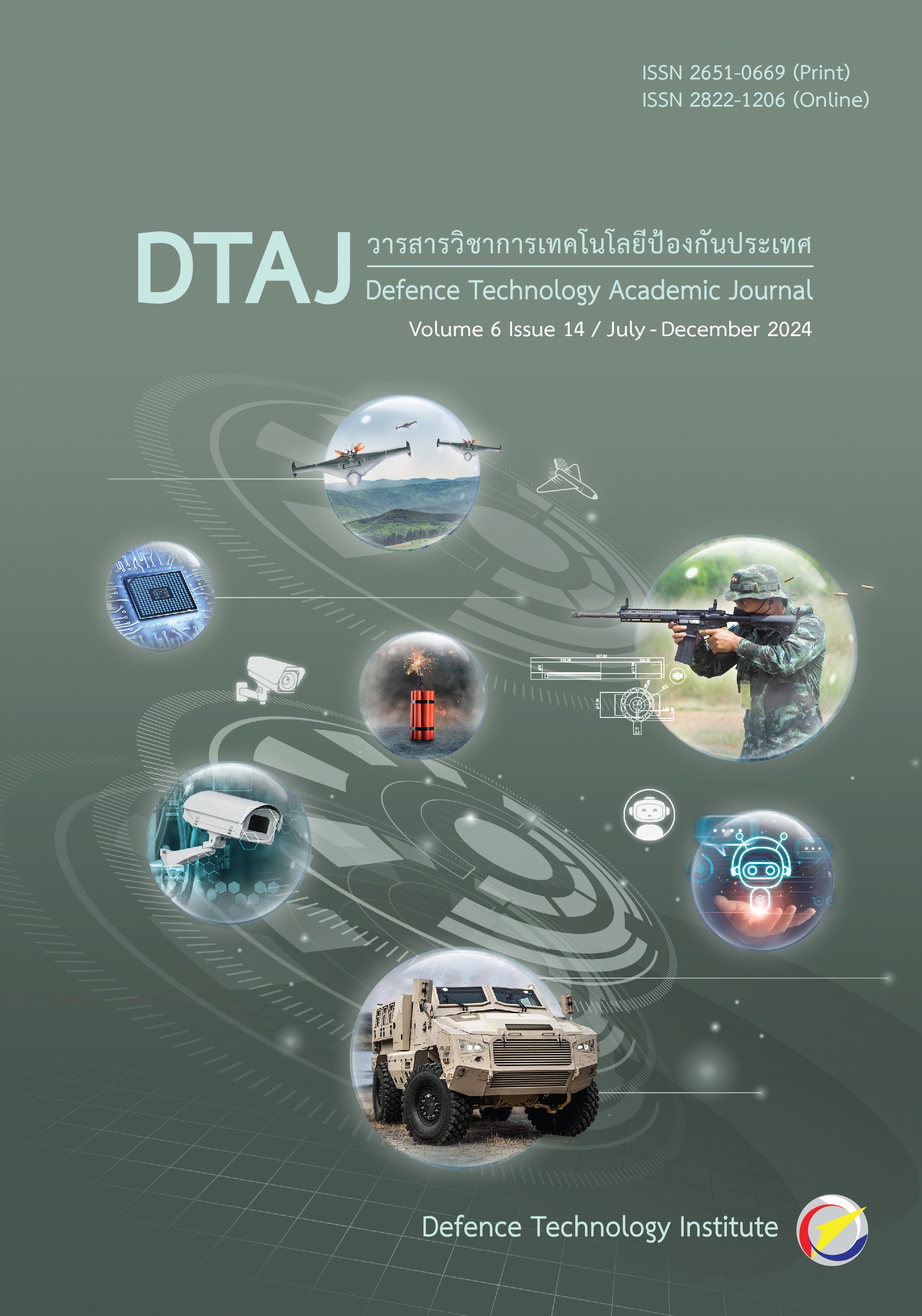Development of Electronic Fuzing System Prototype for Kamikaze Unmanned Aerial Vehicle
Main Article Content
Abstract
Fuze systems are integral components of numerous weapon systems, including artillery
shells, rockets, missiles, and nuclear warheads, enhancing target engagement effectiveness.
The current trend involves the development of armed kamikaze UAVs for both offensive and
defensive applications. These UAVs can be deployed in swarms for second-wave attacks, targeting
fleeing enemy forces, striking troop concentrations, or intercepting incoming missiles and aircraft.
This necessitates a thorough investigation into the operational mechanisms of electronic fuze
systems within the context of kamikaze UAV integration. This research focuses on the design
and development of an effective and safe electronic fuze system for seamless integration with
kamikaze UAVs. The study involves compiling existing knowledge and developing a design that
ensures efficient and reliable operation. The resulting design of the electronic fuze circuit adheres
to MIL-STD-1316 military standards. It comprises two independent, concurrently operating systems,
with key components including a safe & arming circuit, a storage system, a sensing system, and
a detonation system. The fuze system employs a two-stage arming sequence. The initial stage
involves monitoring acceleration data following the kamikaze UAV's takeoff. Once predetermined
parameters and durations are met, the first safety mechanism is disengaged. Upon the UAV's
approach to the target within a specified range, the remaining safety mechanisms are released,
activating the fuze. Upon target impact, the explosive charge is immediately detonated. Based
on this operational analysis, an electronic board has been designed to simulate the arrangement
of real-world electronic components. This prototype serves as a foundation for further research
and development efforts.
Downloads
Article Details

This work is licensed under a Creative Commons Attribution-NonCommercial-NoDerivatives 4.0 International License.
Journal of TCI is licensed under a Creative Commons Attribution-NonCommercial-NoDerivatives 4.0 International (CC BY-NC-ND 4.0) licence, unless otherwise stated. Please read our Policies page for more information...
References
S. Mori, “The Japanese Contribution to Violence in the World: The Kamikaze Attacks in World War II,” Int. forum Psychoanalysis, vol. 28, no. 1, pp. 1-7, 2017. September 2017. [Online]. Available: https://www.researchgate.net/publication/320071487
M. Rutherford. “Kamikaze Drone Loiters Above, Waits for Target.” CNET.com. https://www.cnet.com/science/kamikaze-drone-loiters-above-waits-for-target/ (accessed Mar. 12, 2024).
K. A. Rigby., “Introduction to Weapons Integration,” in Aircraft Systems Integration of Air-Launched Weapons, P. Belobaba, J. Cooper, R. Langton and A. Seabridge, Eds., NJ, USA: Wiley, 2013, pp. 6 - 15.
V. Boulanin and M. Verbruggen, “Mapping the Development of Autonomy in Weapon Systems,” SIPRI, Solna, Sweden, 2017.
Z. Zhang, J. Li, Y. Yang, C. yang, and R. Mao, “Research on Speed Scheme for Precise Attack of Miniature Loitering Munition,” Mathematical Problems Eng., vol. 2020, pp. 1 – 19, 2020, doi: 10.1155/2020/4963738.
S. E. Fowler, G. N. Hemmings, and J. V. McVay, “Self-Checking Arming and Firing Controller,” U.S. Patent 4,541,341, Sep. 17, 1985.
B. S. Davis, E. F. Bukowski, and W. P. D’Amico, “Electronic Safe and Arm Apparatus for Initiating a Pyrotechnic,” U.S. Patent 6,401,621 B1, Jun. 11, 2002.
T. B. Mellor, E. Brogmus, G. E. Dunn P. Willens, and M. L. Sedig, “Rocket Guidance Adapter” U.S. Patent 8,291,827 B2, Oct. 23, 2012.
V. Kumar and R. P. Gaikar, A. Ramchandani, N. Sharma, and P. Raut, “Electronic Time Fuze,” in Int. Conf. Emerg. Trends Electron. & Commun. Eng. (ETECE-2015), Pune, Mahrastra, India, Apr. 2015, pp. 1 - 6.
E. M. Klotz, “The Fuze Industrial Base at Naval Air Warfare Center Weapons Division, China Lake, California,” M.S. thesis, Nav. Postgraduate School, Monterey, CA, USA, 1992. [Online]. Available: http://hdl.handle.net/10945/23686
Engineering Design Handbook: Ammunition Series - Fuzes, U.S. Army Materiel Command, Washington, D.C., 1969, pp 1 - 8.
Fuze Design, Safety Criteria For, MIL-STD-1316E, U.S. Department of Defense, Washington, D.C., USA, Jul. 2015.
S. E. Fowler, “Safety and Arming Device Design Principles,” Nav. Air Warfare Center Weapons Division, China Lake, CA, USA, Rep. NAWCWD TP 8431, 1999.
F. Sauerlaender, “Design Methodology for Safe and Arm Devices,” Nav. Air Warfare Center Weapons Division, China Lake, CA, USA, Rep. NAWCWD TP 8504, 2001.
Naval Air System Command. Description and Characteristics Airborne Bomb and Rocket Fuze Manual. (2008). [Online]. Available: https://info.publicintelligence.net/USNavyRocketBombFuzeManual.pdf
M. Grujicic and W. C. Bell., “Smart-fuze Designand Development Based on Computational Analysis of Warhead/Urban-target Interactions,” Res. Appl. Mech. Eng. (RAME), vol. 2, no. 1, pp. 1 – 10, Mar. 2013.
L. Jianping and W. Bing., “A Ground Monitor Designed for an Electronic Safety and Arming Fuze,” in 2007 8th Int. Conf. Electron. Meas. Instrum., 2007, pp. 4-402 - 4-405.
M. Dennis, B. Hanrahan, and C. Brackmann, “Electronic Fuzing,” Texas Instruments, Texas, USA, 1991. [Online]. Available: https://www.ti.com/lit/an/snoa217/snoa217.pdf
Fuze, Ignition Safety Devices and Other Related Components, Environmental and Performance Tests for, MIL-STD-331D Department of Defense Test Method Standard, May 2017.
S. Singh, S. C. Ramu, P. Kumar, P. K. Reddy, and P. Chinni, “ORNITHOPTER - IoT Based Kamikaze Drone,” in 2023 IEEE 11th Region 10 Humanitarian Technol. Conf. (R10-HTC), Oct. 2023, p. 474.
Business Research Insights. “Electronic fuze market report overview.” BUSINESSRESEARCHINSIGHTS.com. https://www.businessresearchinsights.com/market-reports/electronic-fuzes-market-101687 (accessed Jul. 14, 2024).

